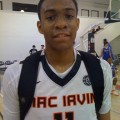A small-town Utah high school boys’ basketball team is making national news headlines in The New York Times, Sports Illustrated, Good Morning America, and NPR, to name a few. What makes them the center of national attention is more than their 26-1 season, their fifth class 5A state championship, and their top ranking in the nation.
The Lone Peak High School Knights basketball team, comprised of “long-armed teenagers who look only slightly more imposing than a chess club,” are from the small communities of Highland and Alpine, Utah—a “region not recognized for basketball prowess.” “Unlike many top high school teams that lure talented players from outside their immediate area,” Lone Peak’s team is pulled from a student body of about 2,300.
“We flunk the eyeball test,” says Coach Quincy Lewis. “We know we’re different whenever we walk into a gym. . . . We know we have something to prove because, honestly, the other teams don’t have a great deal of respect for us.”
“‘There was one team we played that was literally laughing when we were warming up,’ senior center Eric Mika said with a chuckle. ‘And we beat them by 50.’”
 Lone Peak’s style is a “fearless, careening brand of basketball, built on 3-pointers, lobs and dunks, seemingly more suited for a playground than the movie ‘Hoosiers.’”
Lone Peak’s style is a “fearless, careening brand of basketball, built on 3-pointers, lobs and dunks, seemingly more suited for a playground than the movie ‘Hoosiers.’”
Tyrone Slaughter, coach of Whitney Young High School in Chicago, which is ranked seventh in the country, said that Lone Peak plays like “inner-city teams; how blacks consider black teams play. . . . So many times we see the predominantly white teams play a conservative style, a precise style of basketball. When you see this team play, it is completely different.”
Doug Robinson, a writer for the Deseret News said,
“The Knights have stolen the national spotlight because they’re a dominant basketball team that doesn’t look the part. In a wrap, here’s what just happened: A bunch of public-school, clean-cut Mormon boys from a small town in Utah stormed through the basketball season and destroyed everyone’s stereotype of what a championship basketball team is. Too white, too slight, too small-town, the Knights were literally laughed at when they entered the gym. They were an oddity in a game traditionally ruled by black inner-city teams.”
The fact that these players are members of The Church of Jesus Christ of Latter-day Saints, often mistakenly called the Mormon Church, adds to the national interest. The New York Times noted that “a flip through the team program finds plenty of references to Mormonism, whether it is players noting that the last book they read was the Book of Mormon or affirming their life goals as serving a mission and marrying. Lone Peak players freely discuss how religion unites them. When the team is on the road and needs to practice, it will call up the local Mormon bishop and ask to use the small gym typically attached to each Mormon Church.”
Despite promising college careers ahead of them, players already have set their sights on serving full-time missions for the Church of Jesus Christ. Mormons believe that every member is a missionary and has the responsibility to teach the gospel by word and example. In addition, tens of thousands of Mormon youth voluntarily serve full-time missions throughout the world at their own expense and are willing to postpone other interests and goals to do it. Members of the Church of Jesus Christ feel an urgency to share the blessings of the gospel with everyone. In every message, Mormon missionaries teach about the Lord Jesus Christ and how His Atonement and ordinances can enable all people to live with God and their families in heaven after this life.
Worthy and able young men may begin their two-year missionary service for The Church of Jesus Christ when they are at least 18-years-old and have graduated from high school or the equivalent. Young women may begin serving at age 19 and serve for eighteen months.
Knights team leaders Eric Mika, Nick Emery, and T. J. Haws have committed to play for Brigham Young University, but Emery will be leaving on his mission to Germany in May, where he will not play organized basketball for two years. Instead, his efforts will be focused on preaching the Gospel of Jesus Christ.
“‘A lot of factors went into it,’ he said of his decision. ‘I’ve grown up in the Gospel. And I’ve wanted to serve a mission since I was a young kid. I’ll have four years [to play] when I come home.’”
This article was written by Paula Hicken, a member of The Church of Jesus Christ of Latter-day Saints.
 Paula Hicken was an editor with the Neal A. Maxwell Institute for Religious Scholarship from 2000 to 2013. She earned her BA degree in English from Brigham Young University. She edited Insights, the Maxwell Institute newsletter, and was the production editor for Faith, Philosophy, Scripture, Hebrew Law in Biblical Times (2nd ed.), Third Nephi: An Incomparable Scripture, and was one of the copy editors for Analysis of the Textual Variants of the Book of Mormon. She also helped manage the Maxwell Institute intellectual property and oversaw rights and permissions. She has published in the Ensign, the Liahona, the LDS Church News, and the FARMS Review.
Paula Hicken was an editor with the Neal A. Maxwell Institute for Religious Scholarship from 2000 to 2013. She earned her BA degree in English from Brigham Young University. She edited Insights, the Maxwell Institute newsletter, and was the production editor for Faith, Philosophy, Scripture, Hebrew Law in Biblical Times (2nd ed.), Third Nephi: An Incomparable Scripture, and was one of the copy editors for Analysis of the Textual Variants of the Book of Mormon. She also helped manage the Maxwell Institute intellectual property and oversaw rights and permissions. She has published in the Ensign, the Liahona, the LDS Church News, and the FARMS Review.
References:
Additional Resource:
About paulah
Paula Hicken was an editor with the Neal A. Maxwell Institute for Religious Scholarship from 2000 to 2013. She earned her BA degree in English from Brigham Young University. She edited Insights, the Maxwell Institute newsletter, and was the production editor for Faith, Philosophy, Scripture, Hebrew Law in Biblical Times (2nd ed.), Third Nephi: An Incomparable Scripture, and was one of the copy editors for Analysis of the Textual Variants of the Book of Mormon. She also helped manage the Maxwell Institute intellectual property and oversaw rights and permissions. She has published in the Ensign, the Liahona, the LDS Church News, and the FARMS Review.
Twitter •




